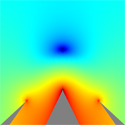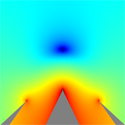Floating and spinning graphene
Graphene, a monolayer of graphite, has interesting structural and electronic properties that have caused it to be the focus of much study, properties it does not exhibit in the bulk, or in proximity to neighboring graphene layers in graphite. Even if mounted on a substrate, the interaction with the substrate can alter graphene’s properties significantly, or even mask them completely. It would be desirable to study this system in splendid isolation; however, unless on a substrate or suspended by attachment to suitably constructed nanostructures, it is very difficult to carry out measurements of graphene samples.
In a paper appearing in Physical Review B, Bruce Kane from the University of Maryland, US, uses techniques developed in atomic and molecular physics to suspend graphene flakes in a quadrupolar ion trap. The device employs specially designed electrodes to produce electric fields that trap charged graphene flakes. The trapped flakes are subsequently detected by laser illumination. It is also found that circularly polarized light can transfer angular momentum and cause the flakes to spin at a very high rotation frequency. Indeed, this study reports the largest rotation frequency ever measured for a macroscopic trapped object. Although this technique is still in its infancy and many refinements are in order, the research may provide new approaches to measurement and modification of graphene when it is not attached to any supporting substrate. – Alex Klironomos





